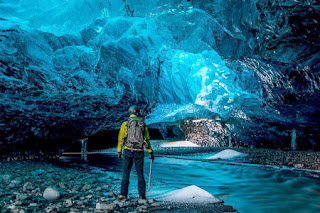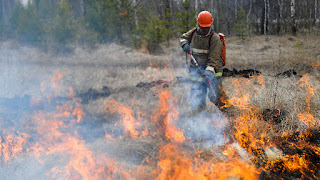Multi-layer
clothing can cause profuse sweating and, therefore, dehydration.
Symptoms.
Urine acquires a rich yellow color, a headache appears.
Treatment.
Make sure that water consumption is sufficient and the balance is maintained.
You should know that when your urine becomes clearer and your head stops
hurting, it means that everything is in order with you and the cells of your
body are filled with water. Do not let dehydration, because it will affect your
ability to think and plan.
Preventive
action. Drink plenty of water every day and do not sweat too much. Clothes
should match the weather.
Hypothermia
This
means that the body temperature is below normal.
Symptoms.
Reduced resistance to cold, trembling, sluggish movements and thinking.
Treatment.
Restore normal body temperature as soon as possible. Place the torso in warm
water (37.7 - 43.3 ° C). Care must be taken in this case, since immersion in
the warm water of the whole body can cause shock and cardiac arrest. In
conditions of survival, the victim is best placed in a sleeping bag with
someone who has a normal temperature. Ideally, if both of them are completely
without clothes. Take action as quickly as possible and, if the person is
conscious, start giving him a hot sweet liquid. After the temperature of the
victim is normalized, do not immediately remove it from the heat source,
because it can again drop the temperature. Give him the opportunity to restore
the heat reserve in the body and, if necessary, continue to drink it with hot
drinks.
Preventive
action. Do not allow a long stay in the cold without food, hot drinks or other
heat sources and do not expose yourself to danger if you are wet and especially
if you are in the wind.
If
you fell into the water while in the polar region:
Quickly
and vigorously swim to shore;
Lie
in the snow, which will absorb some of the water;
Quickly
run into the shelter and keep warm there as soon as possible;
Before
entering the shelter, shake off the snow;
Dry
your clothes, eat and drink a hot drink.
Frostbite
Symptoms.
This is a serious damage to the skin and sometimes other tissues of the body by
frostbite or the formation of ice crystals in the cells of the tissue. This usually
occurs when the temperature is below -12 ° C, but can also be at 0 ° C when
there is a factor in the weather sharpness factor or when the victim is wet.
Since the cold has an anesthetic effect, the victim may not immediately notice
frostbite. Usually frostbitten there are those parts of the body that are least
protected, namely the face, nose, ears, hands and feet. The first signs are
dull, whitish skin color, then the formation of vesicles, the death of some
skin cells and subcutaneous tissue.
Treatment
Warm
up the affected area of the skin and make sure that
there is no frostbite again.
Frozen
hand brushes wrap up in clothes and keep them pressed to the body.
Place
the frostbitten feet in the clothes of your friend.
Do
not pierce the blisters, but powder them with an antiseptic.
On
the affected area, place a surgical dressing or other clean cloth.
Do
not immerse the affected area in hot water or keep it near a fire. Instead, use
body heat.
If a
person experiences severe pain, use morphine.
Serious
cases of frostbite with deep tissue damage should be treated by health
professionals.
Warnings
and Precautions
Do
not wear tight clothing that obstructs blood circulation and increases the risk
of frostbite.
Avoid
staying in the wind as much as possible.
Do
not leave the room in light clothing.
Make
sure that the clothes are dry.
While
in the cold, move the limbs and muscles of the face.
Do
not touch the cold metal with your bare hands.
Especially
be careful if you are tired and you do not have the strength.
Take
care that naked skin does not get gasoline.
Trench
stop
Symptoms.
Long term stay in the cold and in dampness can cause the feet to numb, freeze,
become white and stiff. They will swell and hurt when walking. If you do not
take action, then the situation will be serious, so as soon as possible, dry
your feet and shoes.
Treatment.
Do not rub or massage the feet. Wash them with water and soap, dry and keep in
a raised position. If your legs hurt, do not go. Wear dry socks; Make sure that
you always have a spare pair of dry socks.
Preventive
action. Take care that shoes are dry, and often change socks.
Snow
Blindness
Its
cause is bright sunlight, reflected by snow or amplified by ice crystals of
clouds.
Symptoms.
Hypersensitivity to bright light. Reddened and watery eyes. Strengthening of
reddening of eyes and such sensation, as though in them sand. Loss of vision,
sharp pain in the eyes and a red veil before the eyes.
Treatment.
Immediately put a bandage on your eyes and place the victim in a dark room. A
cool, moist dressing can help relieve pain. It takes time to normalize the
eyes.
Preventive
action. Wear sunglasses. If they are not, make yourself a goggle from the bark
of the tree, carving out the cracks in it. Rubbing charcoal in the skin around
the eyes will help reduce the impact of bright sunlight on the eyes.
Carbon
monoxide poisoning
This
is especially dangerous in a very cold climate, because shelters are usually
small, with well-sealed slots and insufficient ventilation. Carbon monoxide,
which has neither color nor smell, is released by any fuel from any stove.
Symptoms.
They are difficult to identify, especially when this happens to you, they
include headache, dizziness, drowsiness, nausea, and sometimes vomiting; The
victim can also suddenly lose consciousness.
Treatment
Remove
victim to fresh air or a well-ventilated place and make sure that he breathes
deeply.
If
it is unconscious, apply artificial respiration; Place should be well
ventilated.
If
possible, give him oxygen.
When
the victim comes to himself, he needs to rest and drink warm drinks.
The
victim should not perform hard work until full recovery.
Preventive
action. Make sure that the shelters are well ventilated - they must have at
least two ventilation openings. Do not forget that the flame should not be too
high. Before going to bed, douse all the stoves and lamps.






















